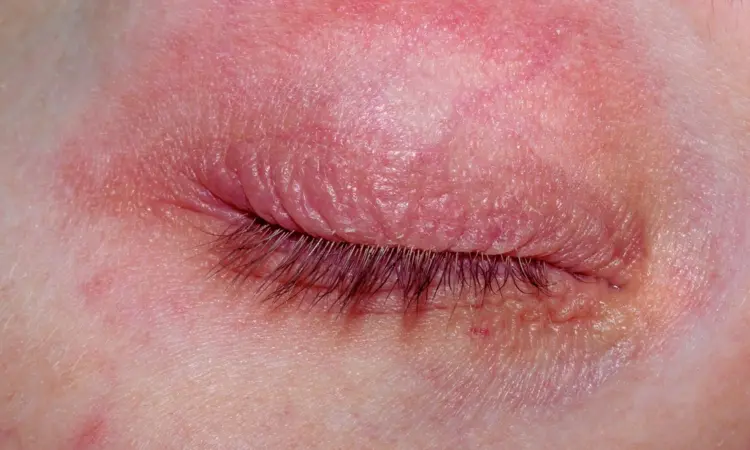- Home
- Medical news & Guidelines
- Anesthesiology
- Cardiology and CTVS
- Critical Care
- Dentistry
- Dermatology
- Diabetes and Endocrinology
- ENT
- Gastroenterology
- Medicine
- Nephrology
- Neurology
- Obstretics-Gynaecology
- Oncology
- Ophthalmology
- Orthopaedics
- Pediatrics-Neonatology
- Psychiatry
- Pulmonology
- Radiology
- Surgery
- Urology
- Laboratory Medicine
- Diet
- Nursing
- Paramedical
- Physiotherapy
- Health news
- Fact Check
- Bone Health Fact Check
- Brain Health Fact Check
- Cancer Related Fact Check
- Child Care Fact Check
- Dental and oral health fact check
- Diabetes and metabolic health fact check
- Diet and Nutrition Fact Check
- Eye and ENT Care Fact Check
- Fitness fact check
- Gut health fact check
- Heart health fact check
- Kidney health fact check
- Medical education fact check
- Men's health fact check
- Respiratory fact check
- Skin and hair care fact check
- Vaccine and Immunization fact check
- Women's health fact check
- AYUSH
- State News
- Andaman and Nicobar Islands
- Andhra Pradesh
- Arunachal Pradesh
- Assam
- Bihar
- Chandigarh
- Chattisgarh
- Dadra and Nagar Haveli
- Daman and Diu
- Delhi
- Goa
- Gujarat
- Haryana
- Himachal Pradesh
- Jammu & Kashmir
- Jharkhand
- Karnataka
- Kerala
- Ladakh
- Lakshadweep
- Madhya Pradesh
- Maharashtra
- Manipur
- Meghalaya
- Mizoram
- Nagaland
- Odisha
- Puducherry
- Punjab
- Rajasthan
- Sikkim
- Tamil Nadu
- Telangana
- Tripura
- Uttar Pradesh
- Uttrakhand
- West Bengal
- Medical Education
- Industry
Rare Case Links Apixaban to Severe Periorbital Dermatitis: Highlights Need for Vigilance in Dermatological Reactions

USA: In a rare clinical presentation, researchers have documented a case of periorbital dermatitis linked to the use of apixaban, a commonly prescribed oral anticoagulant. The case, published in the Wisconsin Medical Journal, emphasizes the importance of considering drug-induced skin reactions in patients with persistent dermatological symptoms of unknown origin.
The case involved a 76-year-old woman who developed intense inflammation and irritation around her eyes, clinically referred to as periorbital dermatitis, approximately three weeks after initiating treatment with apixaban. Despite multiple therapeutic interventions over nearly two years, her symptoms remained unresolved.
The patient was prescribed several treatments, including antihistamines, topical corticosteroids of different potencies, calcineurin inhibitors, and emollients. However, none of these approaches brought lasting or meaningful relief. The breakthrough came after apixaban was discontinued and replaced with another anticoagulant, rivaroxaban. Following this change, the patient’s periorbital dermatitis showed complete resolution, strongly suggesting a causal relationship between apixaban and the skin condition.
Periorbital dermatitis, while relatively common as a dermatologic diagnosis, is seldom reported as a side effect of anticoagulant therapy. According to the authors, this is only the second case documented in medical literature implicating apixaban as a potential cause of this condition.
This case brings attention to the less-recognized cutaneous side effects of direct oral anticoagulants (DOACs), particularly apixaban. Apixaban is used widely for stroke prevention in atrial fibrillation and the management of venous thromboembolism. Its broad application makes awareness of potential side effects particularly important.
Clinicians are encouraged to maintain a high index of suspicion when encountering unexplained dermatological reactions in patients taking this medication.
The authors emphasize the value of considering adverse drug reactions in the differential diagnosis of new or treatment-resistant skin complaints. Identifying the offending agent early can help prevent unnecessary investigations and prolonged patient discomfort, as illustrated in this case.
The findings also support the potential benefit of switching anticoagulants when cutaneous side effects are suspected. Rivaroxaban, which belongs to the same class of drugs as apixaban but has a different molecular profile, was well tolerated by the patient and proved effective without inducing further dermatological issues.
This report aims to broaden clinical awareness and reinforce the need for thorough medication reviews in dermatologic assessments, especially in elderly patients with recent changes in their drug regimens.
"The case is presented to raise awareness among clinicians about the potential dermatologic side effects of apixaban and to highlight the importance of including medication-related reactions in the differential diagnosis of new or unexplained skin conditions," Kelsey Koenig, Waukesha Family Medicine Residency at Prohealth, Waukesha, Wisconsin, and colleagues concluded.
Reference:
Koenig K, Tews G, Downs A. Periorbital Dermatitis Induced by Apixaban. WMJ. 2025;124(1):67-68. PMID: 40262011.
Dr Kamal Kant Kohli-MBBS, DTCD- a chest specialist with more than 30 years of practice and a flair for writing clinical articles, Dr Kamal Kant Kohli joined Medical Dialogues as a Chief Editor of Medical News. Besides writing articles, as an editor, he proofreads and verifies all the medical content published on Medical Dialogues including those coming from journals, studies,medical conferences,guidelines etc. Email: drkohli@medicaldialogues.in. Contact no. 011-43720751


